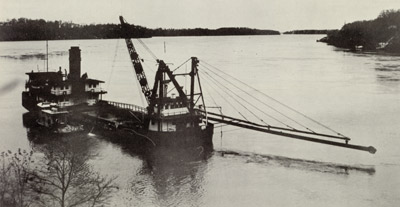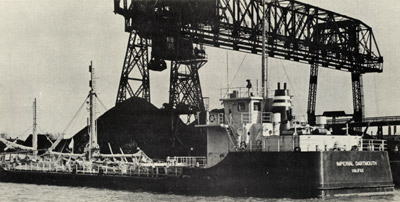Table of Contents
| Title Page | |
| Meetings | |
| The Editor's Notebook | |
| Marine News | |
| A Return Trip for Cibola and Corona | |
| Hail To The Queen... | |
| Sugar Boats | |
| The Quebec And Ontario Transportation Co. Ltd. | |
| Table of Illustrations |
As the usual winter ice began to form around the lakes, the assignment of Canadian icebreakers was announced. Some surprises were included. The ALEXANDER HENRY, usually stationed at Midland during the winter months, will spend the winter at Thunder Bay so as to be ready for the usual spring ice problems at the Canadian Lakehead. The new GRIFFON will replace the HENRY at Midland. The biggest surprise, however, is the entry into the lakes of the 1930-built twin-stacked N.B. McLEAN. She spent the latter part of December at Toronto and then moved on to the Lake Erie area where she will spend the winter. The McLEAN is a familiar sight on the St. Lawrence but on only one previous occasion has she strayed into the lakes. She did a short spell of duty on Lake Erie in the spring of 1969.
We now have further details on the disposition of the Halco tanker. GULF TRANSPORT, which was sold off the lakes this fall. She was purchased on October 31 by Compagnia Armatoriale Siculo Adriatica and cleared Quebec on November 6th manned by an Italian crew. It is believed that she has since been renamed.
Death came on December 6th, 1970, for Capt. John Roen of Sturgeon Bay, Wis., long a well-known figure in lake shipping circles. For a number of years he operated a fleet of tugs and freight barges, and was perhaps best known for his salvaging of the steamer, GEORGE M. HUMPHREY (I) which sank in 1943 in the Straits of Mackinac after a collision with the D. M. CLEMSON. Capt. Roen, a native of Tysse, Norway, also operated trawlers on the East Coast.
HENRY R. PLATT JR., a unit of the Gartland Steamship fleet and inactive since the purchase by American Steamship Co., arrived at Ramey's Bend in the Welland Canal on November 27th in tow of TRAVELLER and HERBERT A. She had lain in Cleveland since 1968 and was apparently resold by Transworld Steel Corp., Panama, to Marine Salvage Ltd. It is not yet clear whether she will be cut up at Humberstone or towed overseas.
Two veteran Columbia Transportation Div. steamers have been sold to Royal Marine Transport Inc., N. Y., for scrapping overseas. They are O.S. McFARLAND and G. G. POST both craneships. The McFARLAND, formerly known as KENSINGTON (17) and M.A.REEB (28), had been idle for a number of years. She was towed to Carrollton, near Saginaw, arriving there on December 3rd to load scrap. However, due to the lateness of the season, it was decided to hold her with storage grain for the winter. Presumably, she will move out next spring for Quebec City, The POST, built in 1902 and named successively LUZON and JOHN ANDERSON, was transferred to a Hamilton, Bermuda, subsidiary, Silloc Ltd., in 1965. She has been laid up at Ojibway, Ontario, since the end of the 1968 season. She was towed to Detroit early in December for loading with scrap but was returned without cargo to Ojibway shortly thereafter.
The Manitowoc Co. Inc., owner of the Manitowoc Shipbuilding Co., purchased the former Christy shipyard property at Sturgeon Bay, Wis., on December 7th, at a foreclosure sale. The Manitowoc marine operations will be moved to Sturgeon Bay where the firm's 650-foot floating drydock will once again be used. It has not been used for some time as a result of its poor location in the Manitowoc yard which was virtually inaccessible to large vessels.
As of December 20th, 1970, the veteran steam carferry, HURON, was still operating under her own power on the C.N. ferry route between Windsor and Detroit. LANSDOWNE was pushed for a one-week period ending December 19th by the McQueen tug, AMHERSTBURG, and this was her first operation since the accident of last summer in which she blew the cylinder head on her port engine. LANSDOWNE looks much as she did as a steamer except that her pilothouse and paddlebuckets have been removed. She still carries the cabins on deck as well as her stacks and engines. The first of the new C.N. tugs was due in Windsor before Christmas, with the second to follow shortly after, so it would appear that the life of HURON will soon undergo a drastic change. The conversion to barge operation is imminent and it is doubtful that she will see more than the first few days of 1971 as a steamer.
It was on November 29th, 1966, that the Bethlehem bulk carrier, DANIEL J. MORRELL, foundered in Lake Huron off Harbor Beach, Mich., a victim of the storm that also severely damaged her sister ship, EDWARD Y. TOWNSEND. Only one man survived the sinking. The loss of the sixty year old ship was in the news again recently when a U.S. District Judge in Cleveland awarded the sum of $2,750,000. to the families of 27 men lost in the sinking. There is still an outstanding claim for injuries suffered by the sole survivor.
A decision is expected in January on whether or not Capt. Burris Wolters of the Tomlinson self-unloader, SYLVANIA, will have his license revoked. It is alleged by the U.S. Coast Guard that, on the night of November 21st, he failed to take the necessary measures to rescue two men who drowned in the Detroit River near Bob-Lo Island.
The new Algoma Central and Hudson Bay Railway self-unloader, AGAWA CANYON, was delivered by Collingwood Shipyards to her owner at Owen Sound on November 20th. She immediately entered service. The new motorship is generally similar to ALGORAIL with the exception of the addition of a transom stern in line with a recent, much-lamented trend in designing ships with as little waste space as possible. Good for the shareholders' wallets, but not for the eye of the shipwatcher.
A move is underway to have the U.S.C.G. dispose of the tender, TAMARACK, recently retired from her duties at the Soo, to the Lake Superior State College for use as a limnological research vessel,
1972 is the date for the start of the contract between Cleveland-Cliffs and the Republic Steel Corp. for the carriage of Republic ore. As a result, Cliffs have already made certain moves to expand their fleet in preparation for the added tonnage. Now comes word that Republic will charter three vessels to Cliffs in 1972 and it is presumed that the ships will be the THOMAS F. PATTON, TOM M. GIRDLER and CHARLES M. WHITE. If this is the case, the future of the other three Republic steamers, SILVER BAY, PETER ROBERTSON and HARRY L. ALLEN, would appear to be unpromising.
An explosion and fire occurred on November 29th aboard the Erie Canal barge, HYGRADE 18, as she was being pushed across Seneca Lake. Three crewmen died in the accident. We have heard of no damage being sustained by the unidentified tug that was pushing the barge loaded with gasoline.
More information is now available concerning the recent accident involving the small steam sandsucker, C. W. CADWELL. On the night of November 25th, she was heading upstream in the Niagara River, bound for the dock at Queenston. For some unexplained reason, she was unable to dock properly and hit the wharf. The result was a rather large dent in the facing on the wharf, and a hole in the ship's bow. Right at the Queenston dock, there is an eddy in the river and the water above the dock near the shore actually flows upstream. The disabled sand boat was caught in this current and was carried upstream several hundred feet and struck a rock near the shore just at the base of Queenston Heights. The impact with the rock punched a hole in the ship's bottom near the bow, and she settled until her bow was submerged almost to the level of the forecastle. The stern remained dry. The CADWELL was raised by the Canadian Dredge & Dock Co. and she was towed to Kingston by G.W.ROGERS arriving there on December 5th. She was placed in the company's drydock there and we understand that she has now been repaired.

C. W. CADWELL rests on the bottom of the Niagara River above Queenston Dock on Nov. 28, 1970. J. H. Bascom photo.
Back in October of 1966, a collision occurred in the Welland Canal just below Port Robinson that saw the self-unloader, STONEFAX, badly holed, take on water and sink just clear of the main channel. Not only was she a difficult salvage proposition, but her cargo of potash fouled both the canal and municipal water systems for many weeks. The Exchequer Court of Canada originally laid full blame for the accident with the STONEFAX, but her owners appealed the decision. The Supreme Court of Canada has now upset the previous ruling and has placed 80% of the responsibility on the other ship involved, the Norwegian. ARTHUR STOVE. The court has refused to completely clear the STONEFAX and has held her 20% at fault.
The newest unit of the Imperial Oil fleet was delivered recently by Collingwood Shipyards. IMPERIAL DARTMOUTH is a bunkering tanker for use in Halifax Harbour, where she will replace the veteran canaller, IMPERIAL CORNWALL. The new ship, powered by conventional diesels rather than by outboard units, was built as Hull 196 of the yard. She passed down the Welland Canal on December 8th bound for the East Coast.

IMPERIAL DARTMOUTH at Port Colborne, downbound, December 7, 1970. W. R. Wilson photo.
Last issue we mentioned several older Canadian carriers that are being converted for oil fuel this winter. We now understand that the same operation will be performed on the Reoch self-unloaders LEADALE and FERNDALE. Both are due to winter in Port Colborne.
Previous Next
Return to Home Port or Toronto Marine Historical Society's Scanner
Reproduced for the Web with the permission of the Toronto Marine Historical Society.